Keeping shed doors open is crucial for ensuring proper ventilation, enhancing accessibility, and adding convenience.

Good ventilation helps prevent the build-up of moisture and mildew, damaging stored items and the structure itself.
Making the shed easily accessible facilitates smoother operations, especially when frequently moving tools and equipment in and out. In this article, we will explore various methods on how to keep shed door open safely and effectively.
These methods include using door stops and holders, installing mechanical or automatic door closers, implementing latch or hook systems, utilizing door chocks or braces, installing retractable door springs, using magnetic door holders, and considering important safety and security measures.
By following these steps, you can ensure your shed door remains open as needed for optimal functionality and convenience while maintaining the integrity and security of the shed and its contents.
Assessing Shed Door Design and Condition
Before you can determine the best method for keeping your shed door open, it’s essential to assess its design and condition.
Start by identifying the type of shed door you have, whether it is a single or double door, and whether it operates by sliding or is hinged. Each type of door has distinct features and may require different solutions to stay open effectively.
Next, thoroughly check the condition of the hinges, door frame, and latch mechanisms. Examine if the hinges are securely fastened and free from rust or damage, which can affect the door’s movement and stability.
Inspect the door frame for any signs of warping, rotting, or structural weakness that might impact the door’s functionality. Additionally, ensure all latch mechanisms are operating smoothly without sticking or jamming.
Finally, identify any potential hazards or obstacles around the shed door area that could interfere with the door remaining open. Look for uneven ground, debris, or objects obstructing the door’s path.
By comprehensively assessing these factors, you can better determine the appropriate method to keep your shed door safely and reliably open.
How to Keep Shed Door Open: Using Door Stops and Holders
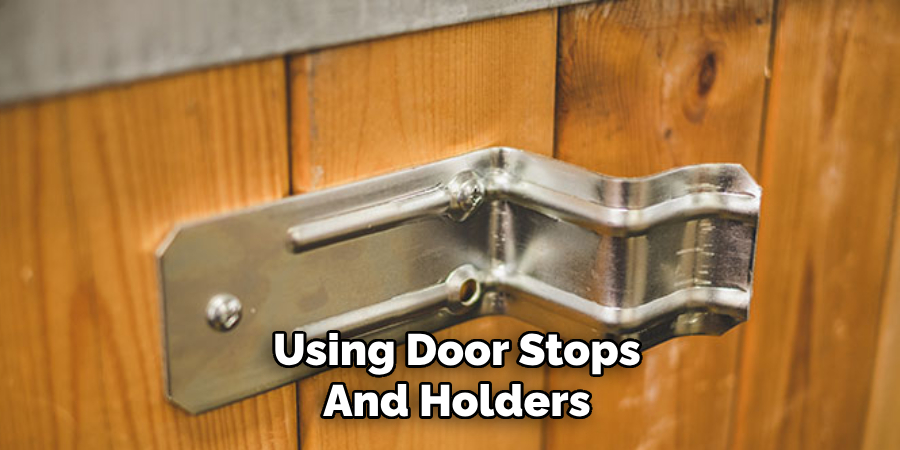
One effective method for keeping a shed door open is using door stops and holders. These devices secure the door in a fixed position, preventing it from swinging shut due to wind or other external forces.
To begin, consider installing floor-mounted or wall-mounted door stops. Floor-mounted door stops are typically placed on the ground, where they catch the bottom of the door, holding it open securely.
On the other hand, wall-mounted door stops are affixed to the exterior shed wall and brace the door from the side or behind. Both options are effective, depending on the door’s operation and installation area constraints.
When choosing the type of door holder, you have several options: magnetic, spring-loaded, or wedge door holders. Magnetic door holders use a strong magnet to secure the door in place, which is particularly useful for metal doors.
Spring-loaded door holders, equipped with a spring mechanism, provide a firm hold and are excellent for wooden or lighter doors. Wedge door holders, made from materials like rubber or plastic, are versatile and can be easily positioned under the door regardless of their construction material.
It’s crucial to ensure that door stops or holders are positioned to be effective against windy conditions. This means placing them at strategic points to prevent the door from slamming shut while also considering the direction and typical strength of prevailing winds in your area.
Secure installation will ensure that the door stops and holders remain in place and function correctly, providing a reliable solution for keeping your shed door open.
How to Keep Shed Door Open: Installing Mechanical or Automatic Door Closers
Mechanical or automatic door closers are excellent solutions for regulating the movement of shed doors, ensuring they remain open as needed and close smoothly when required.
These devices reduce the risk of sudden door slams, which can cause damage or injury, and help maintain the overall safety and functionality of the shed.
You can choose between hydraulic or pneumatic models to install a door closer to your shed door. Hydraulic door closers use liquid to control the door’s movement, providing a smooth and consistent operation.
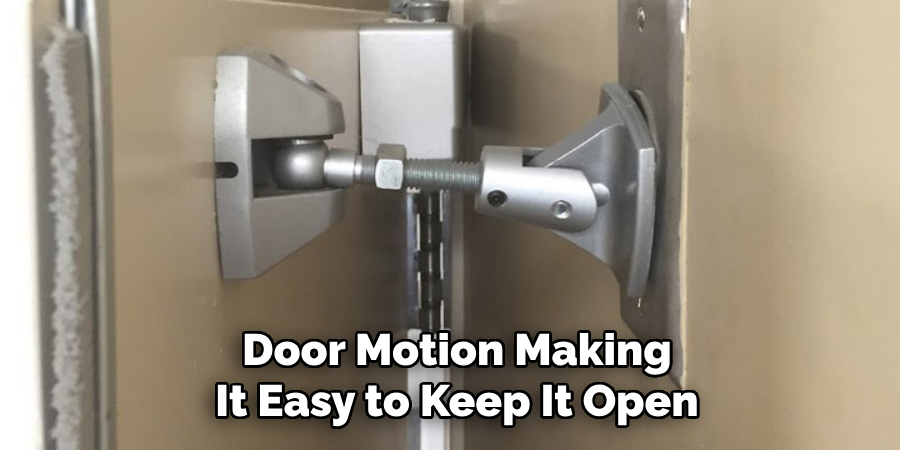
Pneumatic door closers, on the other hand, utilize air pressure to achieve a similar effect. Both types offer effective control over the door’s motion, making it easy to keep it open or close gently.
Begin by selecting a door closer that matches the size and weight of your shed door. Attach the closer to the door frame and the door itself, following the manufacturer’s installation instructions.
Generally, this will involve positioning the closer arm on the door and mounting the closer body to the frame. Make sure all screws and bolts are securely fastened to prevent any loose components.
Once installed, you’ll need to adjust the closing speed and force to match the specific requirements of your shed door. This can typically be done using adjustment screws located on the closer unit.
Test the door’s movement by opening and closing it several times, making incremental adjustments until you achieve the desired operation. Increase the closing force for larger or heavier doors to ensure the door remains stable and moves as intended.
By implementing a hydraulic or pneumatic door closer, you’ll enhance the convenience of your shed door, increase safety, and prolong the life of the door and its components.
Implementing Latch or Hook Systems
Installing simple latch systems or hooks is another effective way to secure your shed doors in an open position.
These straightforward mechanisms offer a reliable and easy-to-use solution, ensuring that the doors remain open during tasks or when increased ventilation is needed.
One of the most popular choices is the adjustable hook-and-eye mechanism. This system consists of a hook attached to the shed wall and an eye screw on the door. When the door is open, the hook fits into the eye screw, holding the door securely in place.
Another commonly used method is the cabin hook, which operates similarly by hooking into a fixed eye, preventing unwanted door movement.

To ensure these latches or hooks function properly, it is crucial to install them securely. Begin by selecting a suitable location where the latch or hook can be easily engaged without obstructing the door’s standard operation.
Use high-quality screws and fixtures to attach the components to both the shed wall and the door, ensuring they are firmly secured.
Regularly inspect the latch or hook mechanism to confirm that it is free from rust or damage, which could hinder its performance.
By using adjustable hook-and-eye mechanisms or cabin hooks and ensuring they are properly installed, you can maintain a stable and open shed door whenever necessary, enhancing both convenience and safety.
Utilizing Door Chocks or Braces
Another effective method for keeping your shed door securely open is by utilizing door chocks or braces. These simple yet versatile tools can be placed under the door edge or used to prop the door open at various angles, offering both ease of use and a reliable grip.
When selecting door chocks or braces, consider the material and design most suitable for your shed door. Wooden or rubber door chocks are excellent for a firm and non-slip hold.
Wooden chocks are sturdy and resilient, while rubber chocks provide a grip that can adapt to various surfaces and door weights. Both options ensure that your shed door remains steadily open without sliding.
To utilize these chocks, simply place one or more under the edge of the open door, adjusting their position as needed to account for varying ground levels or door angles.
Alternatively, adjustable braces or props offer a flexible solution for supporting the shed door in multiple open positions.
These devices can be adjusted in length and angle, allowing you to set the door at precise positions according to your specific requirements.
To use an adjustable brace, fix one end to the door and the other to the ground or a stable surface, ensuring it is securely locked in place.
Integrating door chocks or braces into your shed setup gives you a straightforward and adaptable method for maintaining an open door, suitable for various tasks and weather conditions.
This facilitates ease of access and enhances overall convenience and safety.
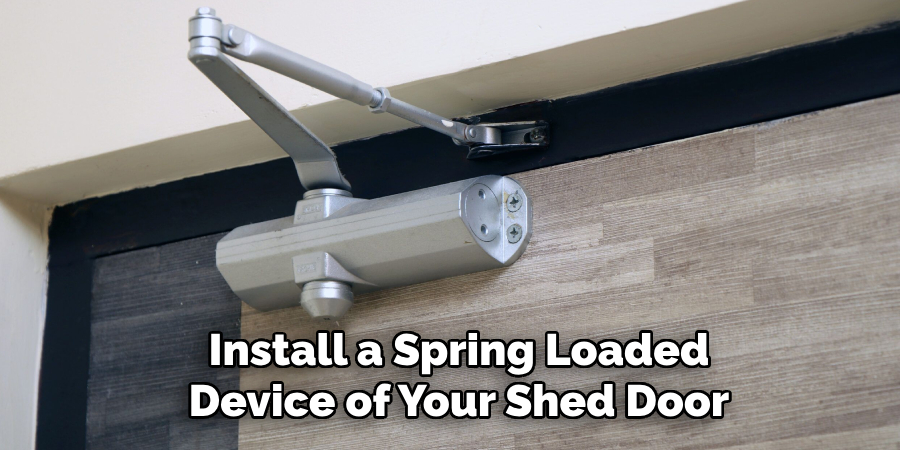
Installing Retractable Door Springs
Exploring retractable spring mechanisms for shed doors is another efficient way to assist in opening and closing. Retractable door springs are designed to make the door operation smoother by providing a balanced force that helps hold the door open or gently pull it closed.
To install a spring-loaded device, start by selecting a spring that matches the weight and dimensions of your shed door. Mount the spring securely to the door frame and the door itself, following the specific guidelines provided by the manufacturer.
Typically, this will involve attaching one end of the spring to the top corner of the door frame and the other to the door, ensuring a firm hold.
When installing these springs, it’s crucial to ensure they are secured properly to prevent any potential hazards. Regularly inspect the spring for any signs of wear or damage and replace it as needed to maintain safety and functionality.
Properly installed retractable door springs provide an excellent balance of convenience and safety, making them an ideal choice for managing the movement of shed doors.
Using Magnetic Door Holders
Installing magnetic door holders on shed doors and frames is a straightforward yet effective way to keep your shed doors securely open.
These holders utilize magnetic force, with one magnet typically mounted on the door and another on the frame. When the door is opened, the magnets connect, holding the door firmly in place.
To install magnetic door holders, start by positioning the magnets at a suitable height where they will reliably engage each other.
Mount the door magnet on the bottom or side of the door and align the frame magnet correspondingly. Use robust screws to ensure both magnets are firmly installed, giving careful attention to the alignment for optimal magnetic attraction.
It is essential to choose magnetic holders that are strong enough to handle the weight of your shed door and resist various weather conditions. Regularly inspect the magnets and their mounting to ensure continued effectiveness.
With strong magnetic door holders, you gain a reliable and hassle-free method for maintaining an open shed door, enhancing convenience and usability.
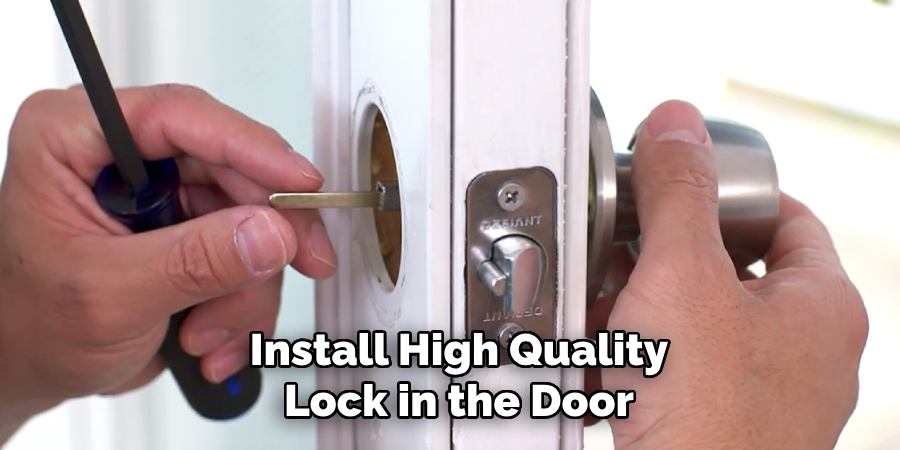
Considering Safety and Security Measures
Ensuring shed doors are secure when not in use is essential to preventing unauthorized access and protecting the contents within.
Implementing strong locks or advanced security devices, such as keyless entry or smart locks, can significantly enhance the protection of your shed. Choose locks that are resistant to picking and cutting, providing robust defense against potential intruders.
In addition to employing high-quality locks, it is crucial to regularly maintain your shed door mechanisms to ensure their ongoing functionality and safety. This includes inspecting hinges, latches, and locks for signs of wear or damage and promptly addressing any issues that arise.
Regular lubrication of moving parts can also help maintain smooth operation and extend the lifespan of your hardware.
Combining these security measures with consistent maintenance ensures that your shed remains a safe and secure space, effectively safeguarding your valuable tools and equipment from theft and damage.
Conclusion
In summary, there are multiple effective methods for addressing the common problem of how to keep shed door open, ensuring both ventilation and ease of access.
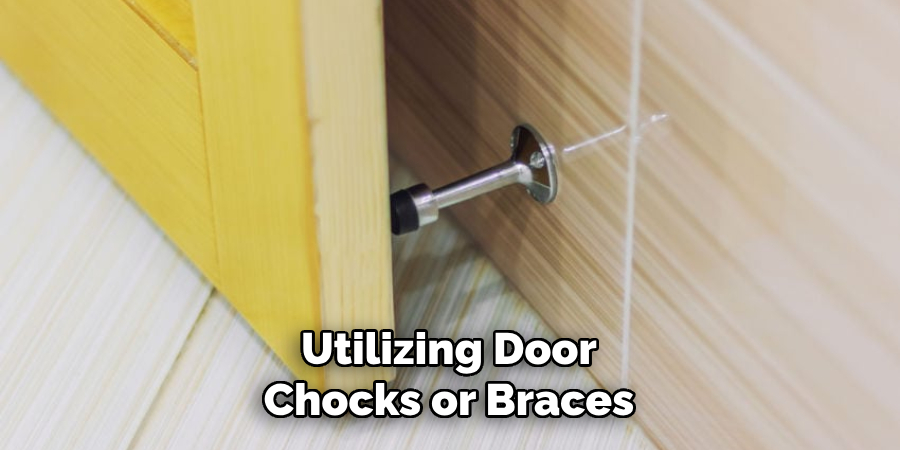
Whether you opt for installing door hooks or latches, utilizing door chocks or braces, exploring retractable door springs, or employing magnetic door holders, each solution offers unique benefits tailored to different shed door types and locations.
We encourage you to assess your specific needs and choose the best method for your shed’s structure and usage patterns. By doing so, you enhance both the functionality and safety of your storage space. Regular maintenance of these components will further ensure their longevity and effectiveness.
Ultimately, integrating these strategies will make accessing your shed more convenient and contribute to a more organized and efficient outdoor storage experience.
Embracing these improvements enhances your shed’s overall functionality and usability, making it a reliable and secure part of your property.

